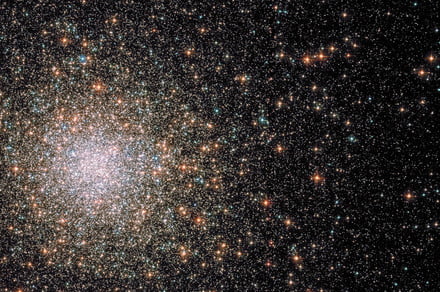Messier 62, a globular cluster imaged by Hubble. The view shows ultraviolet and visible light gathered by the NASA/ESA Hubble Space Telescope’s Advanced Camera for Surveys. ESA/Hubble & NASA, S. Anderson et al.
This week’s Hubble Picture of the Week is a view of the stunning and unusual Messier 62 cluster in the constellation of Ophiuchus.
A globular cluster is a group of thousands of stars which are bound together by gravity, and which move across the sky as one group. The strong gravity means that most such clusters are perfectly spherical, like the neat and orderly Messier 3 or Messier 28 clusters.
But in the case of Messier 62, we see something different. The cluster is warped, with a long tail of stars which stretch out to one side to form a shape like a comet and its tail. It is thought that this distortion is due to Messier 62’s close proximity to the center of the galaxy, where strong gravitational forces from outside the cluster create tidal forces which pull some of the cluster toward the center.
Another noteworthy feature of Messier 62 is how dense it is. Most clusters are more dense in their centers, where many stars are grouped tightly together. But Messier 62 is even more dense than most, with a total mass that is nearly a million times the mass of our Sun. The number of stars close to each other in its center means that there are regularly dramatic events like mergers of two stars happening in this cluster.
An even more dramatic event is the formation of a black hole within the cluster. Astronomers previously believed that when an older star in a globular cluster collapsed and died, that if it formed a black hole it would quickly be ejected out of the cluster due to interactions with other stars. But then they started spotting black holes within globular clusters in other galaxies.
In 2013, a team from the National Radio Astronomy Observatory discovered a black hole in a globular cluster right here in the Milky Way, showing that black holes could survive within a cluster. And the cluster in which the black hole was spotted was none other than Messier 62. Further, it is hypothesized that Messier 62 may be host to a rarely-spotted intermediate mass black hole, but more research is required to confirm this.
Editors’ Recommendations
- See a cluster of cosmic wild ducks in flight in Hubble’s picture of the week
- The most beautiful globular cluster of all: Messier 3, imaged by Hubble
- What does the Milky Weigh? NASA calculates the mass of our galaxy
- Chilean telescope uncovers one of the oldest star clusters in the galaxy
- New Hubble image displays dazzling Messier 28 globular cluster

